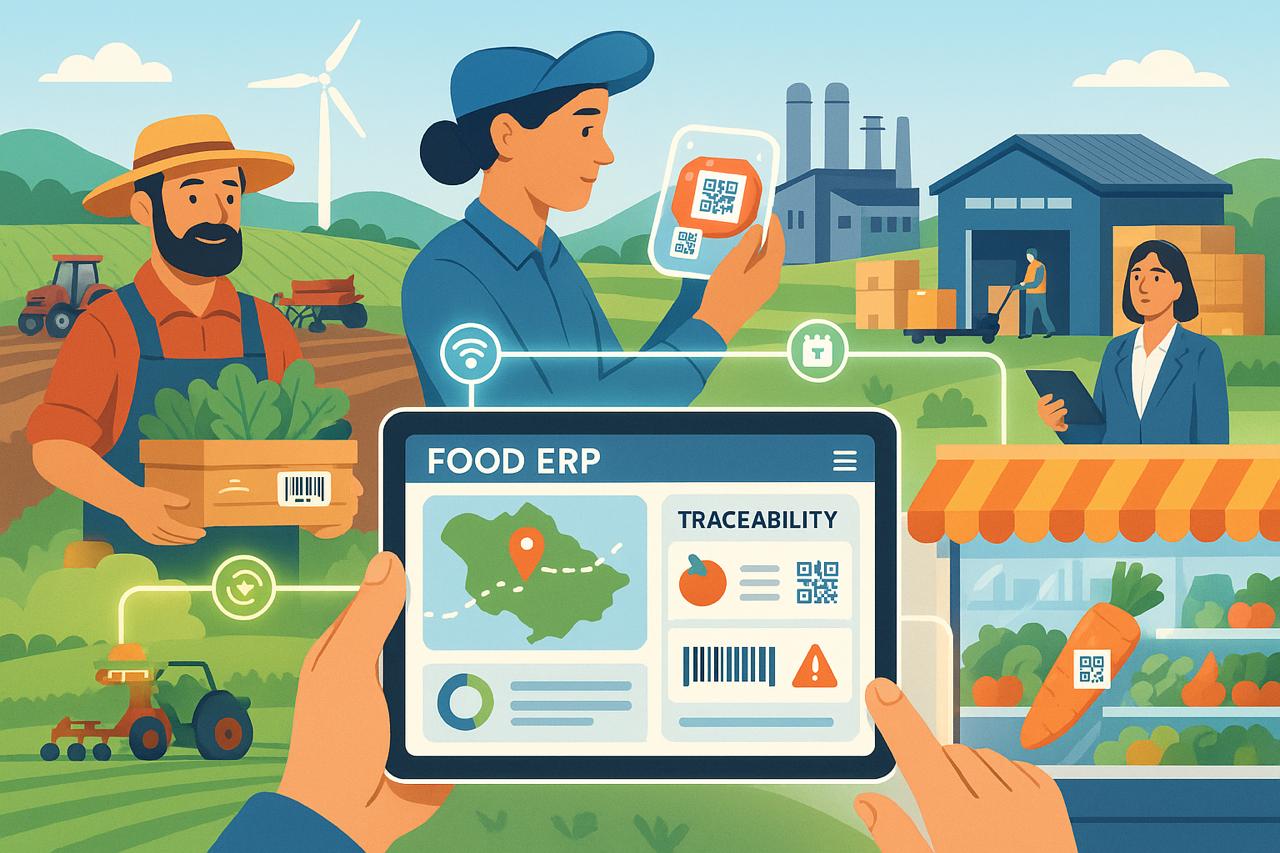Introduction
The agri-food industry is rapidly evolving, driven by a combination of regulatory pressures, shifting consumer expectations, and the increasing complexity of global supply chains. In this dynamic environment, one capability has emerged as a critical mission: traceability.
Whether it’s tracing an apple back to the orchard or a steak to a specific herd, the ability to track food products through every step of the supply chain is no longer optional, it’s essential. Central to enabling this transformation is food ERP software.
Modern food supply chain software isn’t just about automating operations. It’s about connecting the dots from farm to fork and to build trust, ensure safety, and provide real-time visibility into every ingredient, process, and product movement. Solutions such as Food Traceablility Software further enhance these capabilities by strengthening visibility across every stage of the supply chain. In this blog, we’ll explore how food ERP systems are powering end-to-end traceability in food manufacturing, and how integrated upstream tools like cattle management software are extending that visibility all the way back to the source.
The Rising Importance of Traceability
In today’s food economy, transparency is the new currency. Consumers want to know not only what’s in their food, but where it came from, how it was produced, and under what conditions.
At the same time, food safety regulations are becoming more stringent. Authorities like the FDA, USDA, EFSA, and FSMA are enforcing standards that require detailed documentation of every input and process involved in food production. The stakes are high: a single food recall can cost millions, damage brand reputation, and lead to regulatory penalties.
Traceability isn’t just about compliance, it’s about building a resilient, responsive, and responsible supply chain. It enables companies to:
- Quickly isolate and recall contaminated products
- Minimize the impact of food safety incidents
- Maintain audit readiness and meet regulatory demands
- Improve inventory management and reduce waste
- Increase consumer trust and market competitiveness
What Is a Food ERP System?
Food ERP (Enterprise Resource Planning) systems are specialized platforms built to manage the unique operational, regulatory, and safety challenges of the food and beverage industry. Unlike generic ERP solutions, food ERPs are tailored for food processors, manufacturers, and distributors.
At their core, food ERP systems integrate and automate critical business functions such as:
- Procurement and supplier management
- Recipe formulation and batch processing
- Inventory control and warehouse management
- Quality assurance and compliance
- Sales, distribution, and logistics
But their real power lies in traceability technology, the ability to track raw materials, intermediates, and finished goods across the entire product lifecycle.
The Traceability Capabilities of Modern Food ERP Software
1. Real-Time Data Capture
Modern ERP systems are built to ingest data from a variety of sources including barcode scanners, IoT sensors, third-party platforms, and upstream partners. This enables the capture of real-time, accurate data throughout the manufacturing and distribution process.
2. Lot and Batch Tracking
Every product is assigned a unique lot or batch number, which is tracked throughout production. This allows companies to trace any product back to its raw ingredients, production date, processing line, and even the supplier source.
3. Forward and Backward Traceability
A robust ERP enables both forward and backward traceability. Backward traceability helps identify the origin of a product or ingredient, while forward traceability tracks its journey through the production process and into the distribution network.
4. Automated Compliance Reporting
With built-in traceability features, food ERP software can automatically generate compliance documents, audit trails, and safety reports required by regulatory bodies. This reduces administrative overhead and ensures audit readiness at all times.
5. Recall Readiness
In the event of a contamination or non-compliance event, ERP systems make it possible to identify affected batches quickly and issue targeted recalls. This limits financial loss and protects consumer safety.
Going Beyond the Factory Floor: Why Upstream Traceability Matters
While ERP systems offer detailed tracking within the production environment, true end-to-end traceability must begin at the very start of the supply chain at the farm, ranch, or fishery. For meat and dairy processors especially, this means being able to trace products back to the individual animal or herd level.
That’s where cattle management software solutions come in.
Introducing Cattlytics: Extending Traceability to the Source
Cattlytics is a powerful example of how digital tools are transforming upstream operations. As a comprehensive cattle traceability software, it allows ranchers and livestock producers to manage:
- Animal identity, breed, and lineage
- Movement and location history
- Feed and nutrition records
- Health treatments and vaccinations
- Breeding and calving cycles
By digitizing these records and assigning each animal a unique digital ID, Cattlytics enables traceability from birth to processing. When integrated with downstream food ERP systems, it closes the loop, allowing food companies to access origin-level data about their animal protein sources.
Benefits of Integrating Cattlytics with ERP Systems:
- Full visibility from herd to production line
- Proof of compliance with animal welfare and origin labeling laws
- Better risk management by identifying animals exposed to disease
- Data-rich audits for B2B buyers and regulators
- Improved sustainability by tracking emissions, feed, and land use
This kind of upstream-downstream integration is what true digital transformation looks like in the agri-food sector.
Use Case: Beef Processor Leveraging ERP + Cattlytics Integration
Imagine a beef processor sourcing from dozens of ranches across multiple states. With a traditional system, tracking the origin of a contaminated shipment would involve hours (if not days) of manual paperwork and phone calls.
But with Cattlytics capturing cattle data at the ranch level, and that data feeding directly into their food ERP software, the processor gains full transparency. If an issue arises with a specific lot of beef, they can:
- Identify the specific herd and ranch within minutes
- Determine the animal’s feed and health history
- Notify suppliers and distributors instantly
- Isolate only affected batches, minimizing waste and cost
This level of agility isn’t possible without tightly integrated, digital-first systems.
Why This Matters for the Future of Food
The food industry is entering a new era defined by digital ecosystems, data-driven decisions, and radical transparency. As consumer expectations continue to rise and supply chains grow more complex, the need for intelligent, integrated traceability solutions will only increase.
ERP systems are no longer just for internal process management. They are becoming the digital backbone of food businesses, connecting field operations, suppliers, production facilities, and retailers into a single, traceable network.
And by integrating specialized tools like cattle management software, companies can unlock full-chain visibility, safeguard their brand, and position themselves as leaders in safety, sustainability, and innovation.
Final Thoughts
Food ERP software is more than just a digital ledger, it’s a strategic enabler of traceability, compliance, and business growth. When connected to upstream platforms like cattle management software, it empowers food manufacturers to trace every ingredient, every product, and every process in real time.
In a world where trust is earned through transparency, this capability is not just beneficial, it’s essential.





























